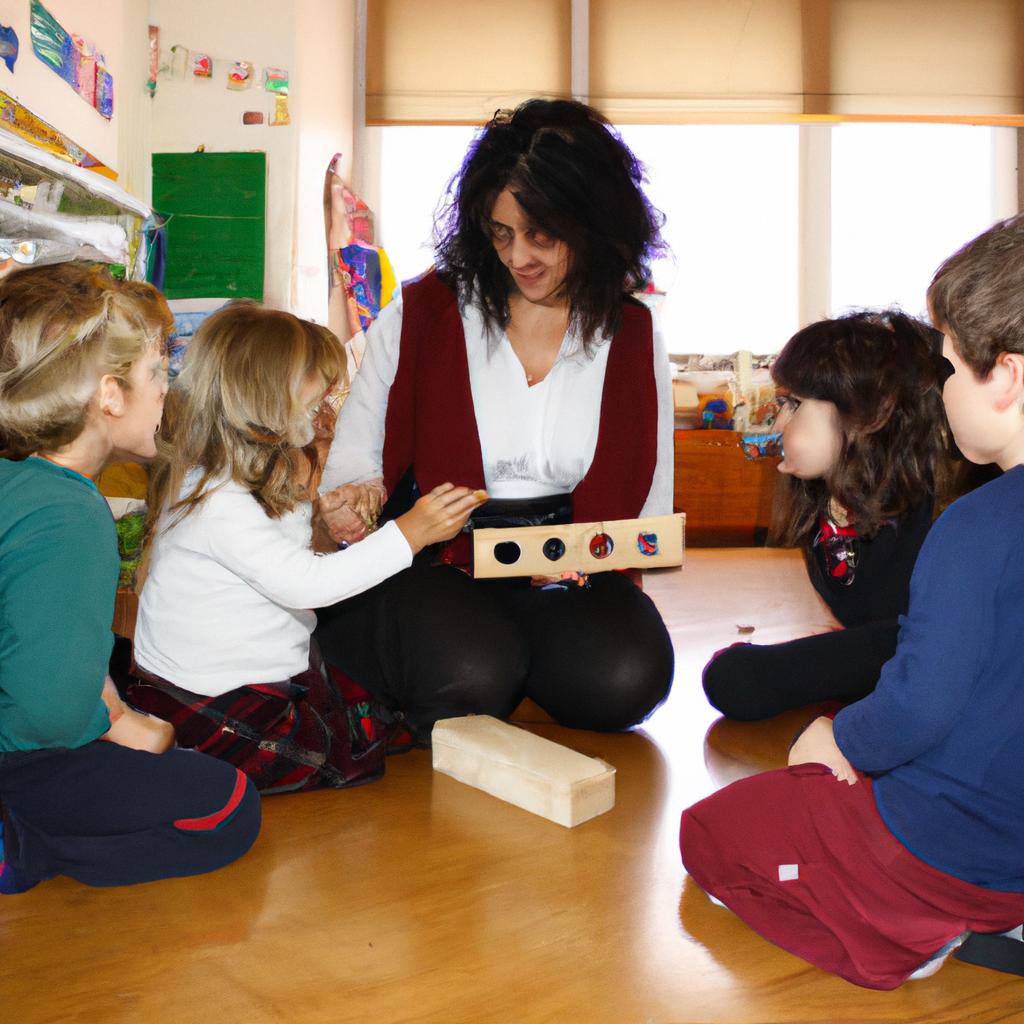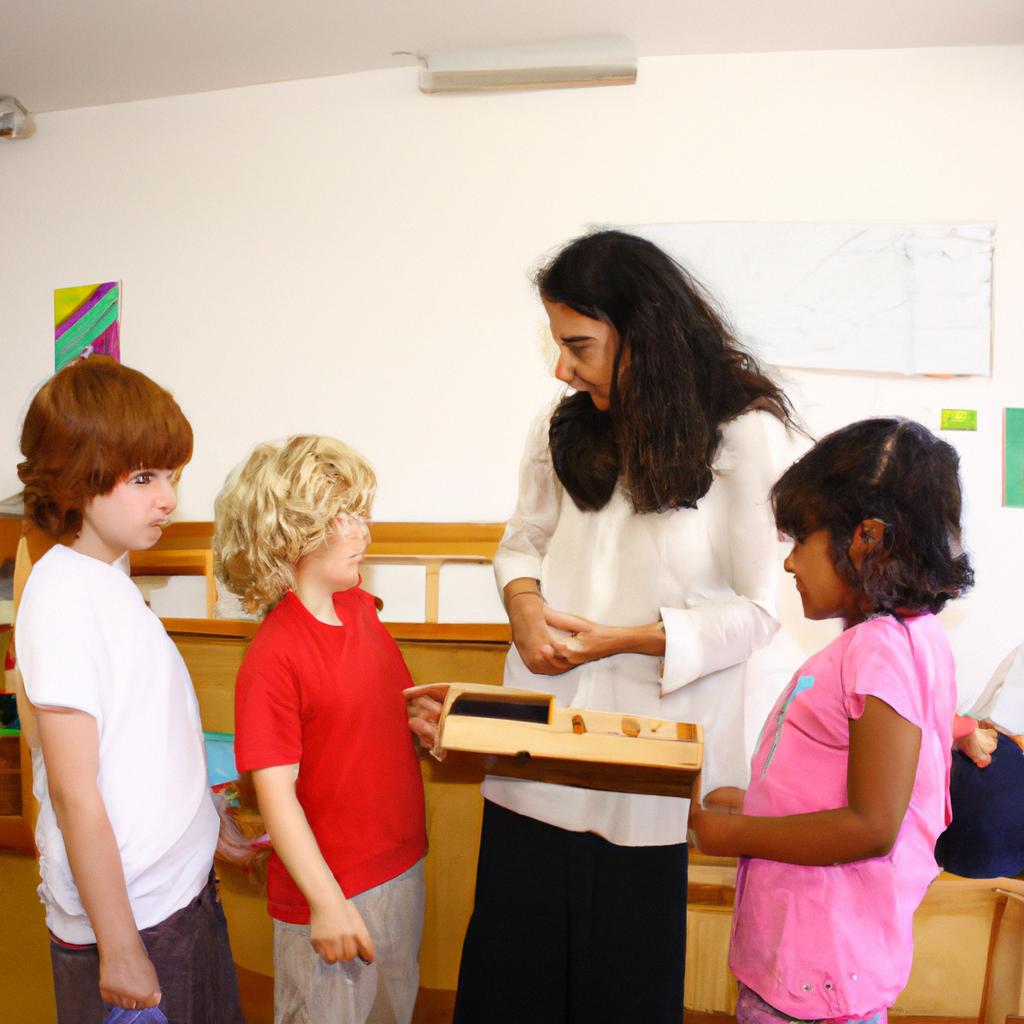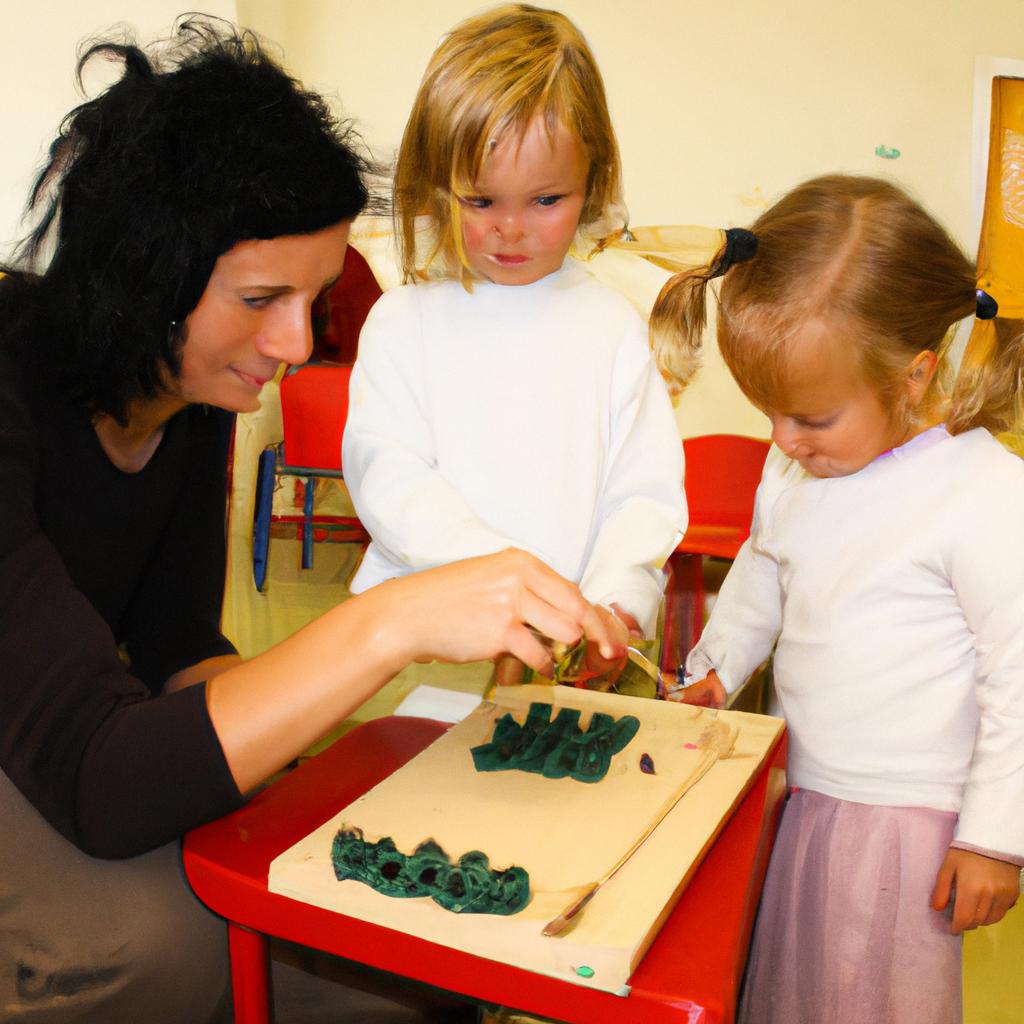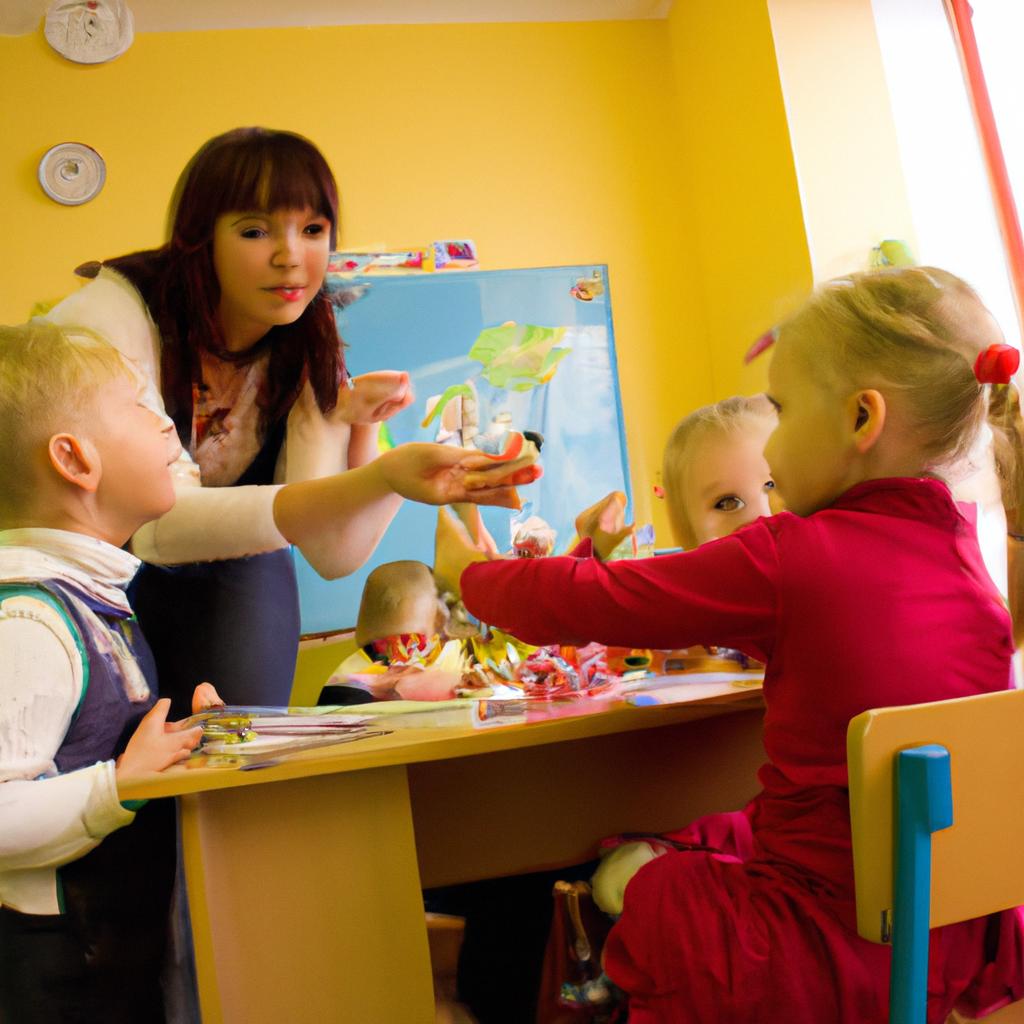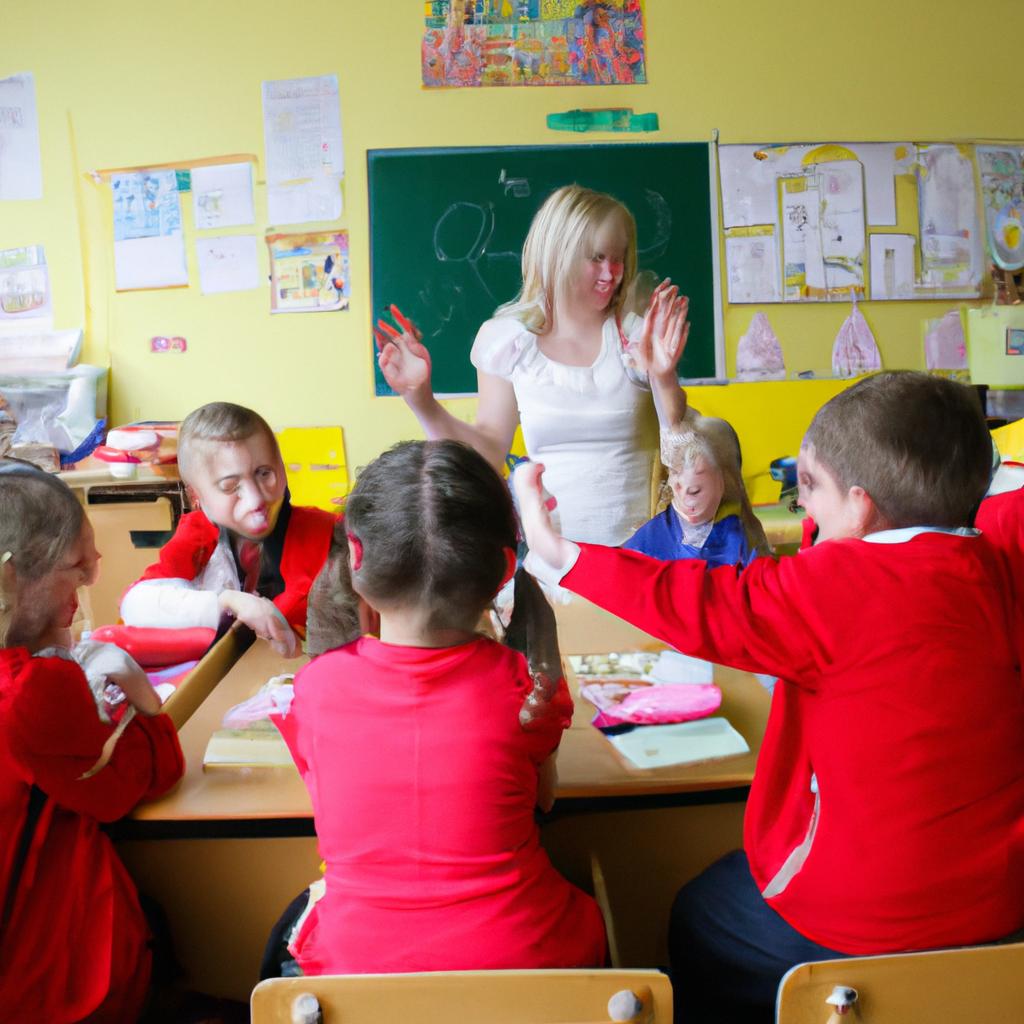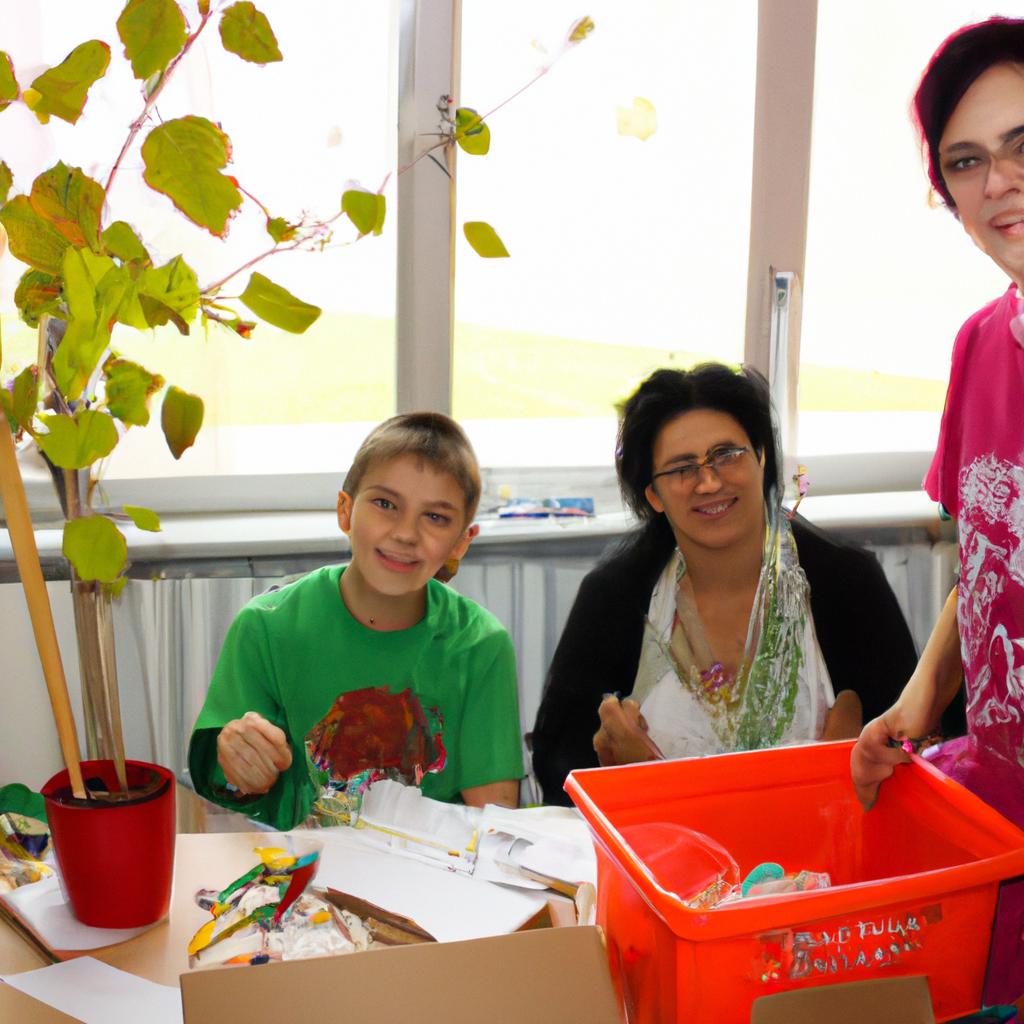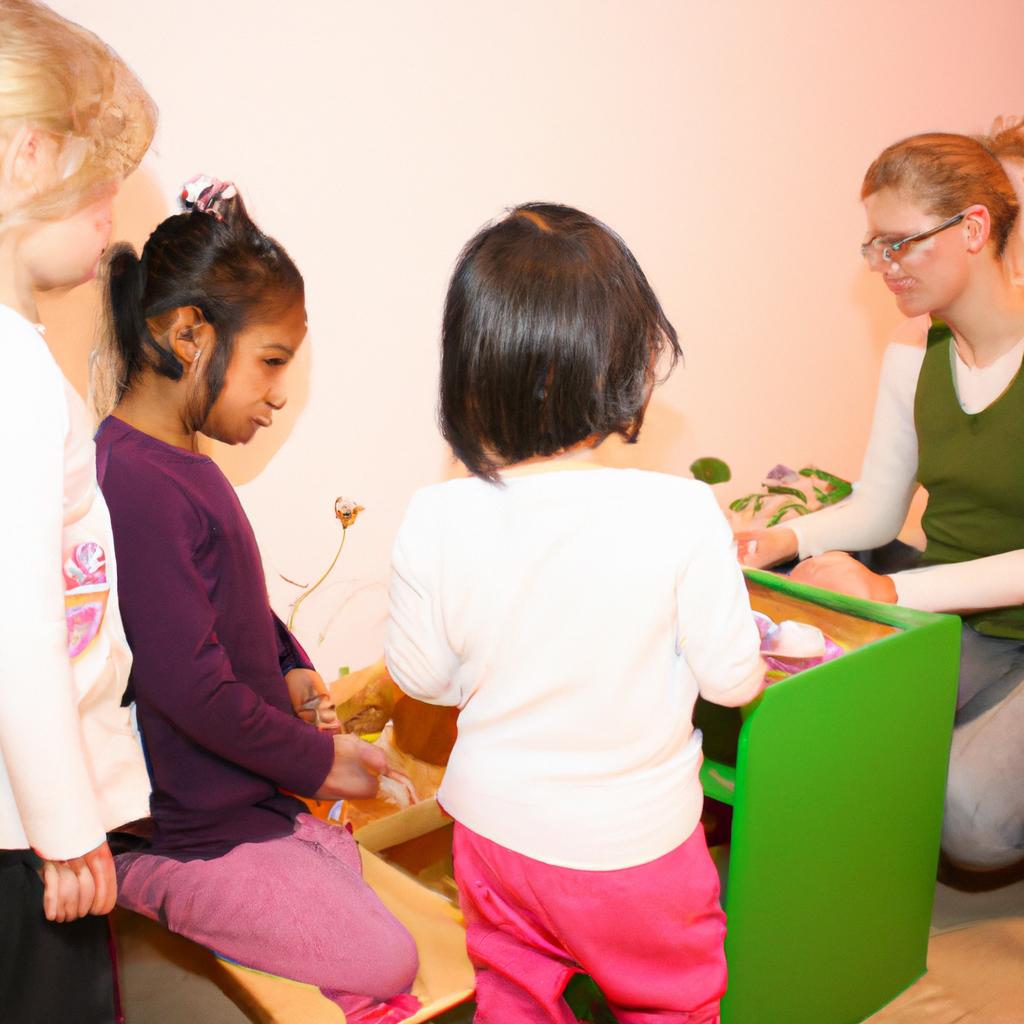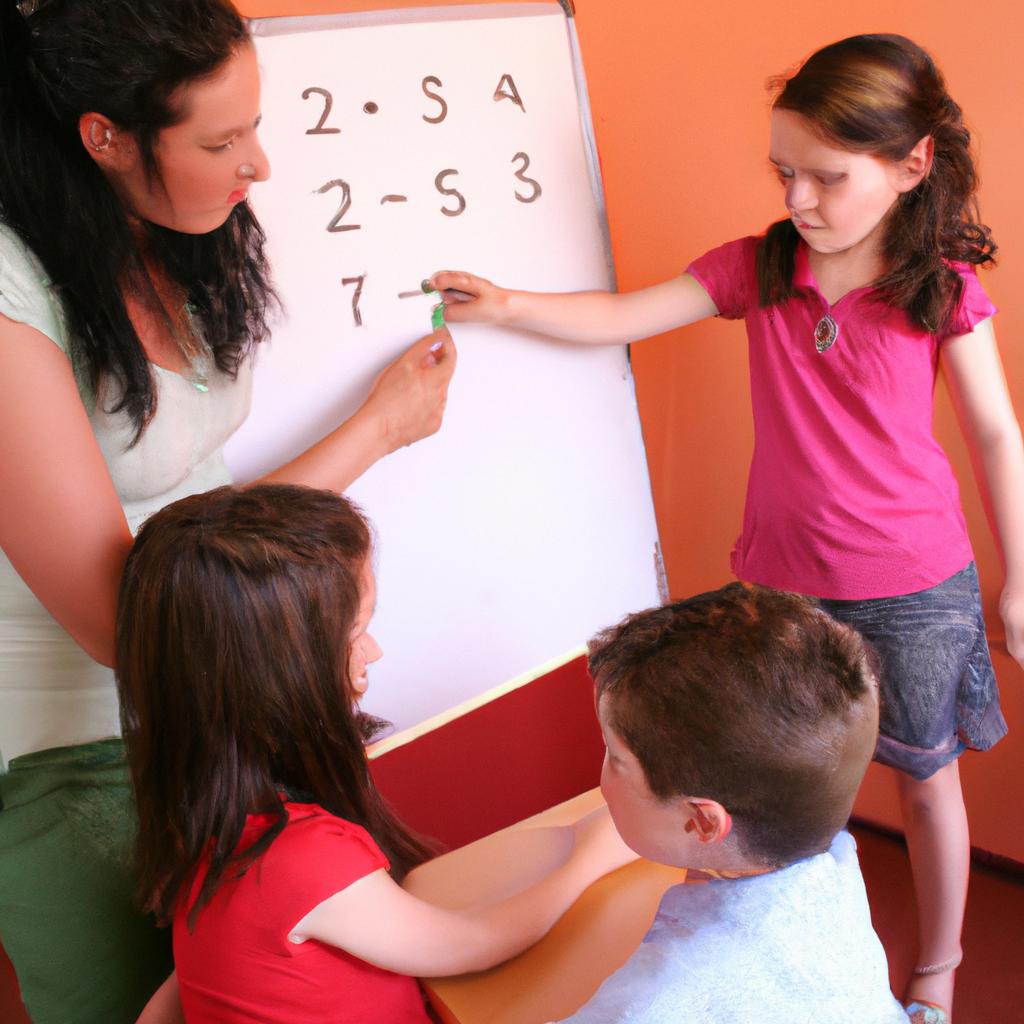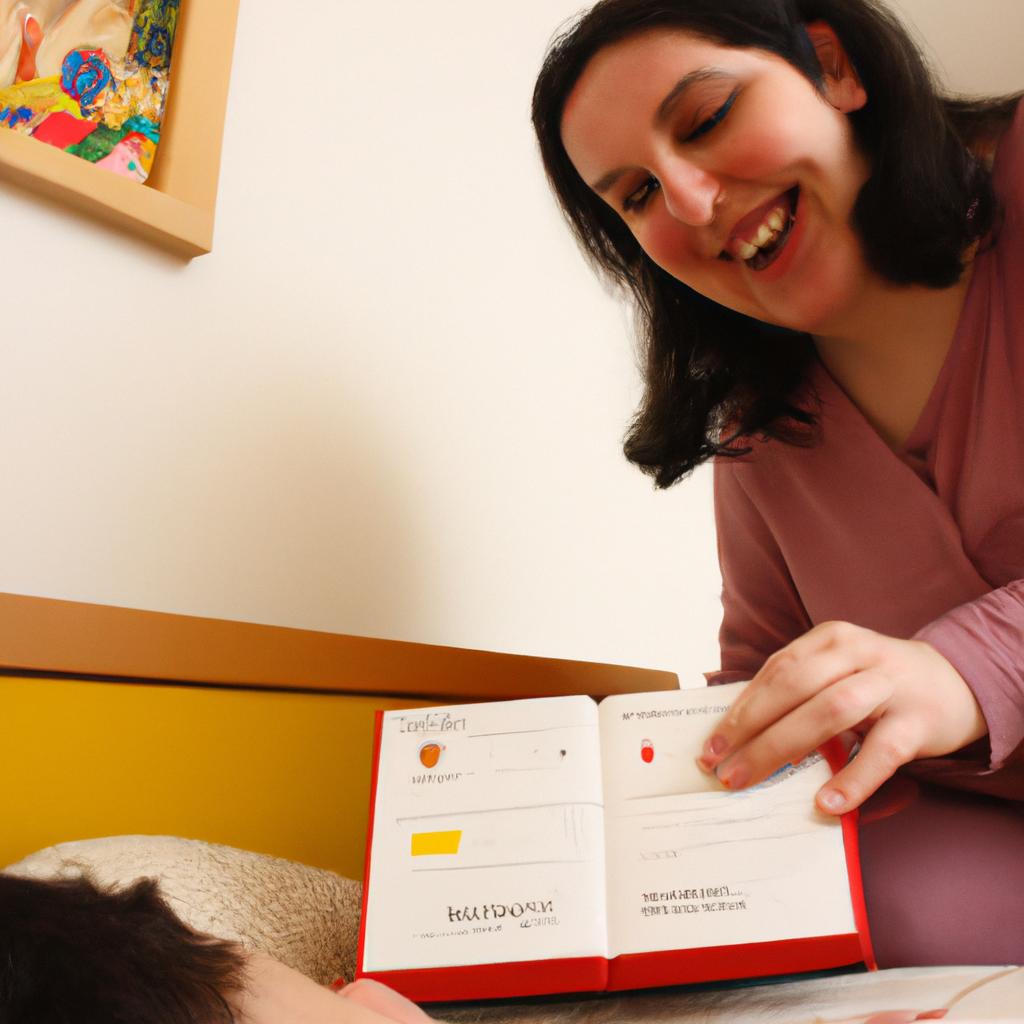One example of an innovative approach to education is the implementation of mixed-age classrooms in Montessori schools. By combining children of different ages within a single classroom, this method aims to provide individualized instruction that caters to each child’s unique needs and abilities. For instance, imagine a hypothetical scenario where a five-year-old named Lily struggles with reading while her seven-year-old classmate, Ethan, excels in this area. In a traditional classroom setting, Lily may feel discouraged or left behind as she struggles to keep up with her peers. However, in a mixed-age classroom, both Lily and Ethan can benefit from personalized instruction tailored to their specific academic levels.
The concept of mixed-age classrooms aligns closely with the philosophy developed by Maria Montessori, an Italian physician and educator who believed that children learn best when given freedom within structured environments. Rather than being confined by strict grade-level boundaries, Montessori classrooms allow for flexibility and adaptability based on each child’s developmental stage and learning capabilities. This pedagogical model recognizes that every student has unique strengths and weaknesses, making it crucial to create an environment where individualized instruction can thrive. Through the use of multi-age groupings, teachers are able to foster collaboration among students while providing targeted support to meet their specific learning needs.
In a mixed-age classroom, older students can serve as mentors and role models for younger ones, fostering a sense of community and collaboration. For example, Ethan, the seven-year-old in our hypothetical scenario, could assist Lily by providing guidance and support during reading activities. This not only helps Lily improve her skills but also cultivates empathy and leadership qualities in Ethan.
Furthermore, mixed-age classrooms promote social-emotional development by encouraging children to interact with peers of different ages. They learn to navigate diverse relationships and develop effective communication skills as they interact with classmates at various stages of cognitive and emotional development. This exposure to diversity fosters a sense of inclusivity and respect for others’ differences – an essential aspect of education that extends beyond academic subjects.
Moreover, mixed-age classrooms allow for more personalized instruction tailored to each student’s abilities. Teachers have the flexibility to differentiate lessons based on individual needs, ensuring that all students are challenged appropriately. For instance, while Lily receives targeted support in reading, Ethan can engage in more advanced literacy activities that suit his level of proficiency. This approach promotes a growth mindset among students as they are empowered to progress at their own pace rather than feeling pressured to conform to arbitrary grade-level expectations.
Overall, mixed-age classrooms provide an innovative approach to education by creating dynamic learning environments where individualized instruction can thrive. By combining children of different ages within a single setting, this model promotes collaboration, social-emotional development, and personalized learning experiences that cater to each child’s unique strengths and weaknesses.
Benefits of mixed-age classrooms
Benefits of Mixed-Age Classrooms
One example that exemplifies the benefits of mixed-age classrooms is a case study conducted at an elementary school. In this study, researchers observed two groups: one consisted of students from only one grade level (homogeneous grouping) and the other comprised students from multiple grade levels (heterogeneous grouping). The results showed that the heterogeneous group exhibited higher levels of collaboration, empathy, and self-motivation compared to their counterparts in homogeneous classrooms.
Mixed-age classrooms offer several advantages over traditional single-grade settings:
- Enhanced social development: By interacting with peers of different ages on a daily basis, children learn valuable skills such as leadership, cooperation, and conflict resolution. Through observing older students’ behaviors and attitudes, younger learners are motivated to emulate positive role models.
- Improved academic growth: In mixed-age classrooms, students have more opportunities for peer teaching and learning. Older students can reinforce their knowledge by explaining concepts to younger classmates while simultaneously deepening their own understanding through teaching. Younger students benefit from this individualized support and gain exposure to more advanced content.
- Increased self-confidence: Being part of a mixed-age classroom fosters a sense of belonging and acceptance. Students feel valued for their unique contributions and abilities rather than being solely defined by their age or grade level. This inclusive environment allows them to develop confidence in themselves as learners.
- Cultivation of empathy and compassion: Interacting with peers who may be at different stages of development encourages children to consider others’ perspectives and needs. They become more empathetic towards those facing challenges or struggling academically, fostering a supportive community where everyone feels understood and respected.
| Benefits of Mixed-Age Classrooms |
|---|
| Enhanced social development |
| Improved academic growth |
| Increased self-confidence |
| Cultivation of empathy |
In summary, mixed-age classrooms provide numerous benefits for both social and academic development. By promoting collaboration, empathy, and self-motivation, these classrooms create a nurturing environment where students can thrive.
How mixed-age classrooms promote individualized instruction
Case Study:
To better understand how mixed-age classrooms in Montessori schools promote individualized instruction, let us consider an example of a hypothetical classroom. In this class, there are children ranging from ages 3 to 6 years old. One particular student, Alex, is five years old and has shown a strong interest in mathematics. Despite being ahead of their peers in this subject area, Alex still enjoys participating actively in other activities within the classroom.
Promoting Individualized Instruction through Mixed-Age Classrooms:
Mixed-age classrooms provide numerous benefits that facilitate individualized instruction for students at different developmental stages. These advantages include:
- Peer Learning Opportunities: In a mixed-age setting, older students can act as mentors or guides for younger ones. This peer-to-peer interaction allows for collaborative learning experiences where older children assist younger ones with tasks or concepts they have already mastered.
- Flexibility in Curriculum Delivery: With students at various levels of development present in the same classroom, teachers can tailor their curriculum delivery to meet individual needs effectively. They have the flexibility to adjust the pace and depth of instruction according to each child’s abilities and interests.
- Enhanced Social Development: Interacting with peers of different age groups fosters social growth among students. Younger learners benefit from observing advanced skills demonstrated by older classmates, while older students develop leadership qualities and empathy through assisting younger ones.
- Increased Self-Motivation: The presence of diverse age groups encourages self-motivation among students as they witness others progressing at varying rates. This environment promotes intrinsic motivation and a desire for personal growth.
Table: Emotional Response
| Emotion | Description |
|---|---|
| Curiosity | Students become curious about others’ progress and achievements |
| Empathy | Older students develop empathy towards younger classmates |
| Confidence | Children gain confidence when helping others or mastering skills |
| Inspiration | Students feel inspired by observing peers at different levels |
In conclusion, mixed-age classrooms in Montessori schools facilitate individualized instruction through various means. Peer learning opportunities, curriculum flexibility, enhanced social development, and increased self-motivation are just a few examples of how this educational approach benefits students across different age groups.
Understanding the advantages of mixed-age classrooms highlights the critical role that Montessori teachers play in fostering an inclusive and supportive learning environment for all students. Let us now explore the importance and responsibilities of these teachers within such settings.
The role of the Montessori teacher in a mixed-age classroom
Transitioning from the previous section, let us explore further how mixed-age classrooms promote individualized instruction by delving into the numerous benefits it offers. To illustrate this, we will consider the hypothetical case study of a Montessori classroom consisting of children aged three to six years.
Firstly, one notable advantage is that mixed-age classrooms allow for peer learning and mentorship opportunities. Younger students have the chance to observe and learn from their older peers who serve as role models. This arrangement fosters a sense of community and cooperation among students, creating an environment where both teaching and learning occur naturally. In our hypothetical classroom, the five-year-old student Emma takes on the role of guiding her younger classmates during practical life activities such as pouring water or tying shoelaces. By engaging in these interactions, Emma not only reinforces her own knowledge but also develops leadership skills and empathy towards others.
In addition to peer learning, mixed-age classrooms offer personalized instruction tailored to each child’s unique developmental stage and learning style. Teachers can adapt curriculum materials according to individual needs while providing appropriate challenges to support growth. For example, in our hypothetical scenario, four-year-old Liam shows exceptional interest in mathematics. With guidance from his teacher, he explores advanced math concepts using specialized Montessori materials designed for older students. Meanwhile, three-year-old Sophia focuses mainly on developing fine motor skills through sensorial activities with smaller objects specifically chosen for her age group.
To highlight the emotional impact of individualized instruction in mixed-age classrooms, consider the following:
- Increased self-confidence: Students gain confidence through opportunities for independent decision-making and problem-solving.
- Improved social skills: Interactions with peers across different ages foster communication abilities and teach valuable lessons about respect and tolerance.
- Enhanced academic progress: Personalized instruction allows students to work at their own pace without feeling rushed or held back by conventional grade-level expectations.
- Strengthened sense of belonging: The supportive and inclusive environment of mixed-age classrooms creates a strong sense of community, where students feel valued and accepted.
To further illustrate the advantages of individualized instruction in mixed-age classrooms, consider the following table:
| Benefits of Individualized Instruction in Mixed-Age Classrooms |
|---|
| Increased self-confidence |
| Improved social skills |
| Enhanced academic progress |
| Strengthened sense of belonging |
In conclusion, mixed-age classrooms offer numerous benefits for promoting individualized instruction. By providing peer learning opportunities, personalized curriculum materials, and tailored guidance from teachers, these classrooms create an optimal learning environment that supports each child’s unique needs and fosters holistic development. In our next section, we will explore how creating a supportive community within mixed-age classrooms enhances the overall educational experience.
Creating a supportive community in mixed-age classrooms
The role of the Montessori teacher in a mixed-age classroom is crucial for creating an effective learning environment. By understanding the unique needs and abilities of each individual student, the teacher can provide tailored instruction that promotes growth and development. This section will explore how Montessori teachers adapt their teaching methods to meet the diverse needs of students in mixed-age classrooms.
For instance, consider a hypothetical case study involving a Montessori teacher named Ms. Johnson and her class consisting of children aged 3 to 6 years old. One of her students, Emily, is exceptionally advanced in math skills compared to her peers. Rather than holding Emily back or separating her from the rest of the class, Ms. Johnson recognizes this opportunity for peer tutoring and assigns Emily as a mentor to help other students struggling with math concepts. Through this approach, both Emily and her classmates benefit from collaborative learning experiences.
To effectively cater to students’ varying levels of readiness and interests, Montessori teachers employ several strategies:
- Individualized Learning Plans: Teachers create personalized plans for each student based on their strengths, weaknesses, and developmental milestones.
- Flexible Curriculum: The curriculum is designed to be adaptable so that it can be modified according to each child’s progress and interests.
- Mixed-Age Groupings: Students are placed in multi-age groups where older children serve as role models and mentors for younger ones.
- Differentiated Instruction: Teachers use various instructional techniques such as hands-on materials, small-group activities, and one-on-one support to accommodate different learning styles.
This table illustrates how these strategies address the diverse needs within a mixed-age classroom:
| Needs/Challenges | Strategies |
|---|---|
| Varying skill levels | Individualized Learning Plans |
| Diverse interests | Flexible Curriculum |
| Peer collaboration | Mixed-Age Groupings |
| Different learning styles | Differentiated Instruction |
By implementing these strategies, Montessori teachers cultivate a supportive community within the mixed-age classroom. Students learn to appreciate and respect each other’s differences, fostering an inclusive learning environment.
Transitioning into the subsequent section about “Addressing challenges in mixed-age classrooms,” it is important for educators to recognize that despite their best efforts, there may be obstacles along the way. By proactively addressing these challenges, teachers can optimize the learning experience for all students.
Addressing challenges in mixed-age classrooms
Building upon the concept of creating a supportive community in mixed-age classrooms, it is essential to explore and address the challenges that may arise within this unique educational environment. By understanding these challenges and implementing effective strategies, educators can ensure individualized instruction for each student’s optimal development.
Addressing Challenges in Mixed-Age Classrooms
To illustrate one challenge faced in mixed-age classrooms, let us consider a hypothetical scenario. In a Montessori classroom consisting of children aged 3 to 6 years old, there may be instances where younger students struggle with certain concepts while older ones are ready to advance. For example, a 4-year-old child might require additional assistance in mastering basic math skills, whereas a 5-year-old peer has already moved on to more advanced mathematical concepts. This discrepancy can create frustration among both students and teachers if not addressed appropriately.
To tackle such challenges effectively, educators must employ various strategies:
- Differentiated Instruction: Tailoring teaching methods and materials according to individual needs allows students at different levels of proficiency to progress at their own pace.
- Peer Collaboration: Encouraging collaboration between students fosters an inclusive learning environment where older children assist their younger peers. This interaction promotes empathy, patience, and enhances social-emotional growth.
- Individualized Learning Plans: Developing personalized plans helps identify specific areas of improvement for each child and provides targeted support accordingly.
- Flexible Groupings: Creating flexible groupings based on skill level rather than age ensures that all learners have opportunities to work with others who are at similar stages of development.
By utilizing these strategies, teachers can overcome the challenges associated with mixed-age classrooms while fostering an engaging and supportive learning atmosphere. However, addressing these obstacles requires careful planning and implementation.
Embracing our commitment to provide comprehensive information about mixed-age classrooms, we will now delve into research supporting the effectiveness of this educational approach. Understanding the evidence-based benefits further strengthens the argument for incorporating mixed-age classrooms into the educational landscape.
Research supporting the effectiveness of mixed-age classrooms
Addressing challenges in mixed-age classrooms can present unique opportunities for individualized instruction. By grouping students of different ages together, educators are able to create a diverse learning environment that fosters collaboration and promotes academic growth. However, it is crucial to address the specific challenges that may arise within this setting.
One challenge faced in mixed-age classrooms is varying skill levels among students. For instance, imagine a hypothetical scenario where a second-grade student named Sarah struggles with reading comprehension while her fourth-grade peer, Alex, excels in this area. In such cases, teachers must employ strategies to cater to each student’s needs effectively. This could involve providing differentiated materials or assigning tasks at appropriate difficulty levels.
Moreover, classroom management can be more complex in mixed-age settings due to differences in maturity levels and social dynamics. To ensure a positive learning environment, educators must establish clear behavioral expectations and promote mutual respect among all students. Additionally, implementing cooperative learning activities can encourage teamwork and empathy across age groups.
Furthermore, assessment methods need to account for individual progress as well as group achievement. Using traditional grading systems may not adequately capture the growth of every student since they often focus on grade-level standards rather than individual development. Instead, alternative approaches like portfolio assessments or rubrics tailored to each child’s abilities can provide a comprehensive overview of their progress over time.
To emphasize the benefits of individualized instruction and its impact on students’ educational experience in mixed-age classrooms:
- Students receive personalized attention based on their unique strengths and weaknesses.
- Peer-to-peer interactions foster a sense of community and inclusivity.
- Collaboration encourages critical thinking skills through discussions and problem-solving activities.
- Opportunities for mentorship emerge as older students guide younger ones towards reaching their full potential.
| Benefits of Individualized Instruction |
|---|
| Personalized Attention |
| Improved Academic Growth |
In conclusion, while mixed-age classrooms offer numerous benefits for individualized instruction, educators must address challenges related to varying skill levels, classroom management, and assessment methods. By implementing strategies that cater to each student’s needs, establishing a positive learning environment, and utilizing holistic assessment approaches, teachers can create an inclusive and effective educational setting that promotes academic growth across age groups.

